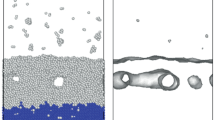Results of molecular-dynamic simulation of structural changes in the surface layer of a design cell of a BCC-crystal under short-term high-energy action are presented. A spatial model where the temperature of the design cell is distributed in accordance with the solution of a linear problem of heat conduction makes it possible to detect disruption of surface layer continuity, including localization of excess free volumes in the form of spherical pores. Dimensions of these imperfections and the time of their existence differ during modeling of laser radiation with different energy density. Conditions are revealed for pore stability during the whole simulation period and a relationship between crystallographic orientation of the “solid – liquid” interphase boundary and sizes of pores formed is determined.





Similar content being viewed by others
References
M. A. Zav’yalova, “Surface modification of quartz glass by a pulsed picosecond laser,” Komp. Optika, 40(6), 863 – 870 (2016).
V. I. Mazhukin, M. NM. Demin, and A. V. Shapranov, “Effects of non-equilibrium with action of pulsed laser radiation on metal,” Opt. Zh., 78(8), 29 – 37 (2011).
T. O. Yavtushenko, A. S. Kadochnikov, S. G. Novikov, et al., “Experimental study of structuring of a metal surface by high power femtosecond laser pulses,” Izvest. Samar. Nauch. Tsentra Ross. Akad. Nauk, 15[4(5)], 1033 – 1037 (2013).
J.-K. Kuo, P.-H. Huang, S.-K. Chien, et al., “Molecular dynamics simulations of crater formation induced by laser ablation on the surface of α-Fe substrate” MATEC Web of Conferences, 167, No. 03011 (2018).
X.-F. Gong, G.-X. Yang, P. Li, et al., “Molecular dynamics simulation of pulsed laser ablation,” Int. J. Modern Phys. B, 25(4), 543 – 550 (2011).
C. Cheng, A. Q. Wu, and X. Xu, “Molecular dynamics simulation of ultrafast laser ablation of fused silica,” J. Phys.: Conf. Ser., 59, 100 – 104 (2007).
M. I. Mendelev, S. Han, D. J. Srolovitz, et al., “Development of new interatomic potentials appropriate for crystalline and liquid iron,” Philos. Mag., 83(35), 3977 – 3994 (2003).
A. Stukowski, “Visualization and analysis of atomistic simulation data with OVITO — the Open Visualization Tool,” Model. Simul. Mater. Sci. Eng., 18, 015012 (2010).
N. N. Rykalkin, A. A. Uzlov, I. V. Zuev, and A. N. Kokora, Laser and Electron Beam Treatment of Materials: Handbook [in Russian], Mashinostroenie, Moscow (1985).
A. Stukowski, “Computational analysis methods in atomistic modeling of crystals,” J. Minerals, Met. & Mater. Soc., 66(3), 399 – 407 (2014).
V. L. Orlov and A. G. Malyshkina, “Formation of nanometric ordered structures of radiation pores,” Izv. Vysh. Uchebn. Zaved., Fizika, 46(2), 31 – 35 (2003).
A. V. Markidonov and M. D. Starostenkov, “Possibility of homogeneous pore generation in grain boundary region under action impact post-cascade waves,” Vopr. Atom. Nauki Tekh., Ser. Matemat. Model. Fiz. Protsessov, No. 3, 37 – 46 (2016).
A. V. Markidonov, M. D. Starostenkov, and E. P. Pavlovskaya, “Effect of post-cascade impact waves on vacancy pore coarsening,” Fund. Probl. Sovr. Mater., 9(4-2), 694 – 701 (2012).
A. V. Markidonov, M. D. Starostenkov, and P. V. Zakharov, “Growth of small vacancy accumulations initiated by sliding post-cascade impact waves,” Pis’ma Mater., 2(2), 111 – 114 (2012).
J. R. Morris and X. Song, “The anisotropic free energy of the Lennard-Jones crystal-melt interface,” J. Chem. Phys., 119(7), 3920 – 3925 (2003).
D. Y. Sun, M. Asta, J. J. Hoyt, et al., “Crystal-melt interfacial free energies in metals: fcc versus bcc,” Phys. Rev. B, 69(2), 020102 (2004).
J. Liu, R. L. Davidchack, and H. B. Dong, “Molecular dynamics calculation of solid-liquid interfacial free energy and its anisotropy during iron solidification,” Comput. Mater. Sci., 74, 92 – 100 (2013).
G. J. Ackland and A. P. Jones, “Applications of local crystal structure measures in experiment and simulation,” Phys. Rev. B, 73(5), 054104 (2006).
Author information
Authors and Affiliations
Corresponding author
Additional information
Translated from Metallovedenie i Termicheskaya Obrabotka Metallov, No. 5, pp. 16 – 21, May, 2022.
Rights and permissions
Springer Nature or its licensor holds exclusive rights to this article under a publishing agreement with the author(s) or other rightsholder(s); author self-archiving of the accepted manuscript version of this article is solely governed by the terms of such publishing agreement and applicable law.
About this article
Cite this article
Markidonov, A.V., Starostenkov, M.D., Gostevskaya, A.N. et al. Modeling by a Molecular Dynamics Method of Structural Changes of a BCC Metal Surface Layer with Short-Term High-Energy External Action. Met Sci Heat Treat 64, 258–263 (2022). https://doi.org/10.1007/s11041-022-00796-9
Received:
Published:
Issue Date:
DOI: https://doi.org/10.1007/s11041-022-00796-9




